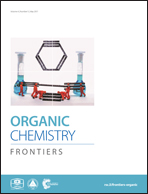The effect of a highly twisted C![[double bond, length as m-dash]](https://www.rsc.org/images/entities/char_e001.gif) C double bond on the electronic structures of 9,9′-bifluorenylidene derivatives in the ground and excited states†
C double bond on the electronic structures of 9,9′-bifluorenylidene derivatives in the ground and excited states†
Abstract
We synthesized methyl-substituted 9,9′-bifluorenylidene (9,9′-BF) derivatives in which two planar fluorene units are connected through a C![[double bond, length as m-dash]](https://www.rsc.org/images/entities/char_e001.gif) C double bond. The C
C double bond. The C![[double bond, length as m-dash]](https://www.rsc.org/images/entities/char_e001.gif) C double bond is twisted owing to the steric crowding between the fluorene units, and by introducing substituents at 1,1′-positions (inner space of 9,9′-BF) it becomes more twisted. Indeed, single crystal X-ray structural analysis and theoretical calculation reveal that the dihedral angle between two fluorene π-planes of a 1,1′-dimethyl-substituted 9,9′-BF is 56°, which is clearly larger than those of pristine 9,9′-BF (42°) and 1-methyl-substituted 9,9′-BF (50°). The twisted conformation of 1,1′-dimethyl-substituted 9,9′-BF facilitates the cis–trans isomerization process which we assessed quantitatively by variable-temperature NMR measurements. The 9,9′-BF derivatives with different numbers of methyl groups also exhibit remarkable changes in optoelectronic properties, primarily because of the change in the twisting angle of the central C
C double bond is twisted owing to the steric crowding between the fluorene units, and by introducing substituents at 1,1′-positions (inner space of 9,9′-BF) it becomes more twisted. Indeed, single crystal X-ray structural analysis and theoretical calculation reveal that the dihedral angle between two fluorene π-planes of a 1,1′-dimethyl-substituted 9,9′-BF is 56°, which is clearly larger than those of pristine 9,9′-BF (42°) and 1-methyl-substituted 9,9′-BF (50°). The twisted conformation of 1,1′-dimethyl-substituted 9,9′-BF facilitates the cis–trans isomerization process which we assessed quantitatively by variable-temperature NMR measurements. The 9,9′-BF derivatives with different numbers of methyl groups also exhibit remarkable changes in optoelectronic properties, primarily because of the change in the twisting angle of the central C![[double bond, length as m-dash]](https://www.rsc.org/images/entities/char_e001.gif) C double bond. Theoretical calculation further indicates that the electronic structures of methyl-substituted 9,9′-BF derivatives in the excited states are considerably different from those of pristine 9,9′-BF.
C double bond. Theoretical calculation further indicates that the electronic structures of methyl-substituted 9,9′-BF derivatives in the excited states are considerably different from those of pristine 9,9′-BF.
![Graphical abstract: The effect of a highly twisted C [[double bond, length as m-dash]] C double bond on the electronic structures of 9,9′-bifluorenylidene derivatives in the ground and excited states](/en/Image/Get?imageInfo.ImageType=GA&imageInfo.ImageIdentifier.ManuscriptID=C7QO00125H&imageInfo.ImageIdentifier.Year=2017)
- This article is part of the themed collection: Novel π-electron molecular scaffolds


 Please wait while we load your content...
Please wait while we load your content...
![[double bond, length as m-dash]](https://www.rsc.org/images/entities/h2_char_e001.gif) C double bond on the electronic structures of 9,9′-bifluorenylidene derivatives in the ground and excited states
C double bond on the electronic structures of 9,9′-bifluorenylidene derivatives in the ground and excited states